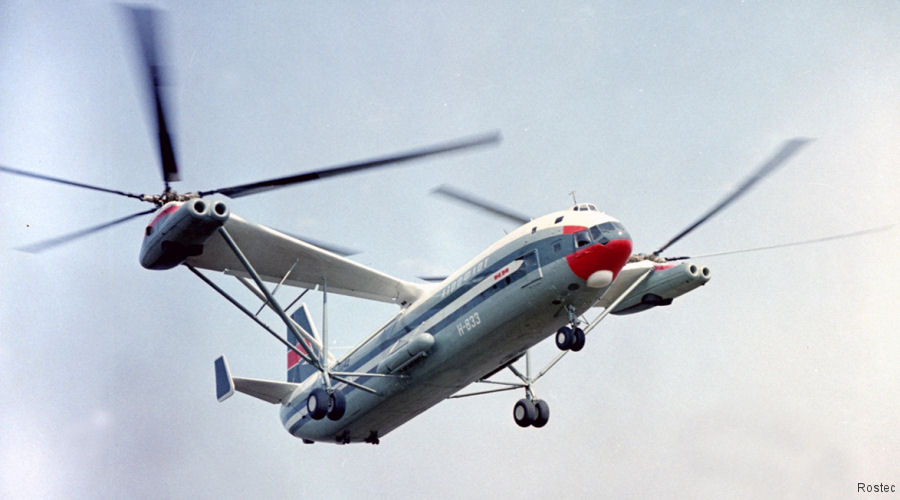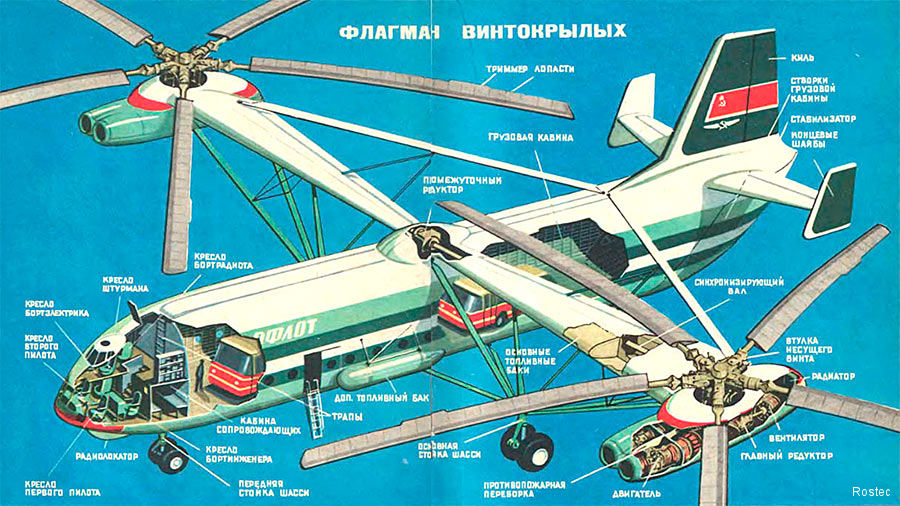
Rostec, July 10, 2022 - 54 years ago, the first flight of the Mi-12, the largest and most havy lifting helicopter ever built in the world, made its first flight.
It is still striking in its size with each engine nacelle almost the size of a fighter.
In May 1971, the Mi-12 became the main sensation of the Le Bourget air show. True, the fate of the unique aircraft was not at all smooth.
The giant helicopter Mi-12 was the last work for Mikhail Leontievich Mil, a kind of epilogue of the creative path of this outstanding aircraft designer. In fact, the helicopter never received the Mil brand name, remaining forever in history as an experimental V-12 helicopter that did not go into series.
In the late 1950s and early 1960s, in the conditions of the Cold War, the Strategic Rocket Forces of the USSR increased their potential. According to the adopted strategy, missile bases are being built in a secret way and far away from populated areas and major highways. At the same time, non-separable ballistic missiles need to be delivered there somehow, and railway tracks or runways can easily unmask secret objects. The military decide to bet on a transport link by plane to the nearest airfield, and then by helicopter to the base. For such a task a special, super-heavy equipment was needed, which has yet to be created.
The first sketches of the new aircraft were made back in 1959. Young engineers of the bureau took an active part in the work, with whom Mikhail Leontievich always easily found a common language. In 1961, the terms of reference for a helicopter with a carrying capacity of 20-25 tons were formed.
For a detailed study of the longitudinal scheme, a Piasecki Vertol V-44 model was purchased in the USA. Mil comes to the conclusion that although the design was correct it was not suitable for solving the task. In addition, Mil's colleague and eternal competitor Nikolai Kamov presented his own version of the transport aircraft - the Ka-22 rotorcraft (a hybrid of an airplane and a helicopter), made according to a transverse scheme. Mil turns to her, anticipating great prospects here.
In April 1965, a decree was issued on the construction of the first experimental V-12, and preparations for the production of the first batch at the Saratov Aviation Plant immediately began. By the beginning of the summer of 1967, the prototype was ready for testing.
However, the first takeoff ended in an accident. On June 27, the V-12 climbed to a height of 10 m, and previously unknown self-oscillations appeared in the control system, forcing the pilot to an emergency landing with the destruction of one landing gear. The cause was quickly identified, and in about a year the error was eliminated. But this story made a strong impression on Mikhail Leontyevich: for the first time, the designer's aircraft did not take off the first time.
A year later, on July 10, 1968, the V-12 made its first flight. And then the helicopter was waiting for a series of triumphs. In 1969, seven world records were set including lifting a load of 40.2 tons to a height of 2250 m, which has not been beaten to this day.
In 1971, after the death of Mikhail Mil, the helicopter flew under its own power to the air show in Le Bourget, France, where kilometer-long queues line up for the outlandish aircraft. The American Helicopter Society awards the Mil Design Bureau with the I.I. Sikorsky.
But the further fate of the helicopter did not work out. By the time the V-12 brilliantly passed all the tests, it was actually no longer needed by the military, its capabilities turned out to be excessive.
The era of high-precision spy satellites was coming and secrecy in the location of the bases no longer played the same role, besides, a number of missiles for which the V-12 was built did not reach mass production.
Some of the tasks were solved with the help of a new, more economical Mi-26 with a traditional single-rotor scheme thus ending the V-12 history . The two prototypes can now be seen at the Monino Air Force Museum and at the National Helicopter Center.
It is still striking in its size with each engine nacelle almost the size of a fighter.
In May 1971, the Mi-12 became the main sensation of the Le Bourget air show. True, the fate of the unique aircraft was not at all smooth.
The giant helicopter Mi-12 was the last work for Mikhail Leontievich Mil, a kind of epilogue of the creative path of this outstanding aircraft designer. In fact, the helicopter never received the Mil brand name, remaining forever in history as an experimental V-12 helicopter that did not go into series.
In the late 1950s and early 1960s, in the conditions of the Cold War, the Strategic Rocket Forces of the USSR increased their potential. According to the adopted strategy, missile bases are being built in a secret way and far away from populated areas and major highways. At the same time, non-separable ballistic missiles need to be delivered there somehow, and railway tracks or runways can easily unmask secret objects. The military decide to bet on a transport link by plane to the nearest airfield, and then by helicopter to the base. For such a task a special, super-heavy equipment was needed, which has yet to be created.
The first sketches of the new aircraft were made back in 1959. Young engineers of the bureau took an active part in the work, with whom Mikhail Leontievich always easily found a common language. In 1961, the terms of reference for a helicopter with a carrying capacity of 20-25 tons were formed.
For a detailed study of the longitudinal scheme, a Piasecki Vertol V-44 model was purchased in the USA. Mil comes to the conclusion that although the design was correct it was not suitable for solving the task. In addition, Mil's colleague and eternal competitor Nikolai Kamov presented his own version of the transport aircraft - the Ka-22 rotorcraft (a hybrid of an airplane and a helicopter), made according to a transverse scheme. Mil turns to her, anticipating great prospects here.
In April 1965, a decree was issued on the construction of the first experimental V-12, and preparations for the production of the first batch at the Saratov Aviation Plant immediately began. By the beginning of the summer of 1967, the prototype was ready for testing.
However, the first takeoff ended in an accident. On June 27, the V-12 climbed to a height of 10 m, and previously unknown self-oscillations appeared in the control system, forcing the pilot to an emergency landing with the destruction of one landing gear. The cause was quickly identified, and in about a year the error was eliminated. But this story made a strong impression on Mikhail Leontyevich: for the first time, the designer's aircraft did not take off the first time.
A year later, on July 10, 1968, the V-12 made its first flight. And then the helicopter was waiting for a series of triumphs. In 1969, seven world records were set including lifting a load of 40.2 tons to a height of 2250 m, which has not been beaten to this day.
In 1971, after the death of Mikhail Mil, the helicopter flew under its own power to the air show in Le Bourget, France, where kilometer-long queues line up for the outlandish aircraft. The American Helicopter Society awards the Mil Design Bureau with the I.I. Sikorsky.
But the further fate of the helicopter did not work out. By the time the V-12 brilliantly passed all the tests, it was actually no longer needed by the military, its capabilities turned out to be excessive.
The era of high-precision spy satellites was coming and secrecy in the location of the bases no longer played the same role, besides, a number of missiles for which the V-12 was built did not reach mass production.
Some of the tasks were solved with the help of a new, more economical Mi-26 with a traditional single-rotor scheme thus ending the V-12 history . The two prototypes can now be seen at the Monino Air Force Museum and at the National Helicopter Center.

Mi-12 cutaway drawing

Mi-12 compared with the Mi-2
See also |
Mil Helicopters




